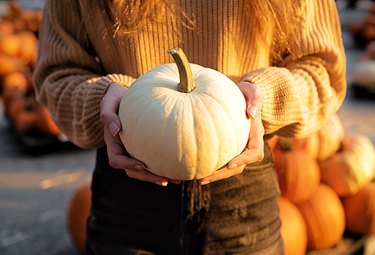
Traditional orange pumpkins (Cucurbita moschata, USDA hardiness zones 3-9) are seen everywhere in the fall, but white pumpkins (Cucurbita maxima, USDA hardiness zones 3-9), or ghost pumpkins, add a nice variety to decorating schemes. You can also eat them like orange pumpkins since some varieties have a sweet taste and a texture that make them great for baking. The next question is: When should these pale pumpkins be harvested?
When to Pick Pumpkins
Video of the Day
The rule of thumb for harvesting pumpkins is that they should reach their fully colored skin, or rind, color, whether it be orange or white. The rind also needs to be firm; you can push a fingernail into it to test this. If it goes through quickly or it makes a noticeable indentation, that pumpkin is too soft to harvest. If you don't want to leave a mark on a future Jack-o-lantern, you will probably want to do this fingernail test on the back of the pumpkin.
Video of the Day
You can also check the pumpkin's stem and vine. If the vine has dried up and is pulling away from the stem or is withered and twisted, if the pumpkin is in full color and if the rind is hard, then it is ready to be taken home. Also, keep in mind that frost harms pumpkins, so don't wait too long or you'll lose it to the elements.
When Do Pumpkins Turn Orange?
The pumpkin harvesting process begins when the plant's yellow pumpkin blossoms start to wilt and die. If the female ones have been successfully pollinated, the small dark green fruits will start showing up soon after. You'll need to wait approximately 45 to 55 days before the pumpkins are ripe and ready for picking. Some of the most popular large pumpkin varieties are two hybrids: Kratos, which are flat-round and weigh up to 30 pounds, and Cronus, which can be twice as heavy with a blocky-round shape.
Ghost pumpkins can be round or squat with a flattened shape, and the rinds are white or ivory; the flesh inside can be white or orange. White pumpkins never turn orange on the outside, but their rinds can take on bluish and yellowish tones as they mature. They average 8 to 15 pounds, but larger ones can weigh as much as 90 pounds. There are several varieties of white pumpkins, including Lumina, Cotton Candy, Baby Boo and Casper.
How to Grow White Pumpkins
You can buy seedlings, harvest pumpkins seeds or buy ready-to-plant ones. If you get them from a pumpkin, you need to put them in a colander under cold water to rinse off the pulp. Pick the fattest seeds and let them air dry. You should select a spot that gets full sunlight or light shade with well-draining soil. Pumpkins prefer a soil pH ranging from 6 to 6.8. They develop large vines and fruit, so space the seeds 5 feet apart for larger varieties.
Sow the seeds 1 foot deep and once the plants grow to 1 foot tall, start feeding them a nitrogen-based fertilizer. They do best when watered very early in the morning; if you add mulch and use a soaker hose, you'll get the best results. When the vines start spreading, change to a high-phosphorous fertilizer. You can prune the vines when they start getting too long by simply pinching off the fuzzy ends. Remove leaves shading the pumpkins and harvest after they pass the readiness tests.